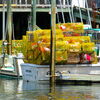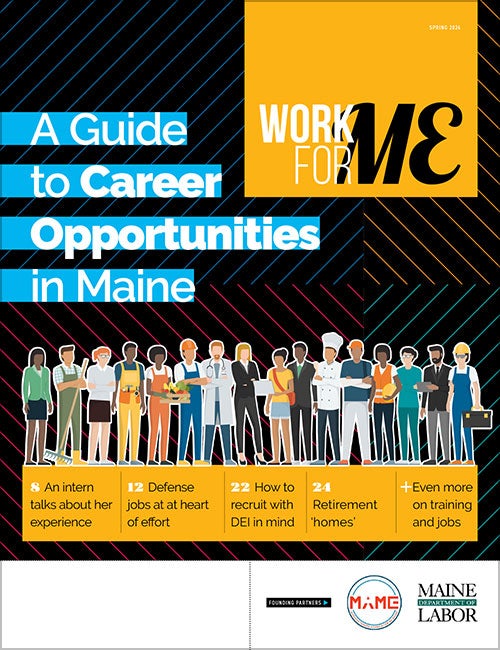Processing Your Payment
Please do not leave this page until complete. This can take a few moments.
Cultivating clusters | What does it take to grow Maine's economic clusters? Time, money, patience - and a lot of networking
 Photo/David A. Rodgers
Map man: Blue Marble Geographics' Patrick Cunningham says efforts to organize the GIS cluster need to be formalized
Photo/David A. Rodgers
Map man: Blue Marble Geographics' Patrick Cunningham says efforts to organize the GIS cluster need to be formalized
For several years, Maine has been keen on technology clusters. The state, like the world over, has embraced this trendy economic development model for its promise of generating innovation, new products and well-paying jobs.
Successful clusters can turn into legends: Silicon Valley has technology and Napa Valley has wine. Detroit has autos and Bangalore is the global home of software outsourcing. Maine once was home to famous clusters in the textile and shoe industries.
The state made a move seven years ago to understand and build clusters here when the Maine Science and Technology Foundation commissioned a study by the University of Southern Maine’s Muskie School of Public Service to find concentrations of like-minded technology companies. State officials wanted to fuse and grow these mini-economies with grants and extra attention. The presumed pay-off was that clusters would become magnets for startups or businesses from away, boosting the region’s prosperity.
The report, released in 2002, found that Maine lacked strong clusters, although some areas showed promise, especially in composites and advanced materials. This year, the Maine Technology Institute again released a cluster report, once more led by economist Charles Colgan, a professor at the Muskie School. And the updated analysis, “Maine’s Technology Sectors and Clusters: Status and Strategy,” reveals an altered picture of Maine’s cluster economy.
For starters, it has diversified: Five fledgling clusters have seemingly sprouted up across the state like mushrooms. Measuring and controlling devices, biomedical research, green products, new media and bioinformatics have all emerged as “potential” clusters, according to the report. Three other clusters are listed as “emerging,” and eight more — from aquaculture to chemical engineering — are considered “sustainable.” (For a complete list of clusters in Maine, see “Strength in numbers,” below.)
These potential and emerging clusters were discovered when the researchers scoured the marketplace for evidence of nascent clusters, looking for deep pockets of shared industry knowledge.
And as experts’ understanding of clusters changes, the Maine Technology Institute has a legislative mandate to continue building the state’ innovation-based economy. These cluster studies are critical blueprints for MTI as it steers the state’s limited R&D dollars and grants to technology organizations.
Patrick Cunningham, president of Gardiner-based Blue Marble Geographics, a mapping software company in Maine’s emerging geospatial technologies cluster, says that cluster needs more nurturing to grow. He notes that more collaboration and perhaps collective marketing among the businesses — as well as more R&D assistance from the state to develop new products — would be appreciated. “I would like to see something more formalized,” he says.
It is not, however, just up to the state to build nascent technology clusters; the onus is on industry members, too. In conversations with a few owners of businesses within the so-called “potential clusters,” most indicated that stronger industry ties could help their businesses. To that end, many described ideas that are percolating or are already underway.
Now Maine is armed with new focal areas that could continue to develop, or fizzle. “It is not at all a given that they will become successful or sustainable,” Colgan says, referring to the nascent clusters. Sustainability, he explains, happens in a region that contains a deep pool of knowledge and skills that continually feed new ideas, products and businesses. “These are abilities that sustain success through several cycles of the market.”
Cluster evolution
Where did the new clusters come from? While these activities have grown in the past five years, what has perhaps changed more significantly is the research team’s perception of clusters. (Colgan had help from PolicyOne Research in Scarborough, Planning Decisions Inc. in Hallowell, and the Columbus, Ohio-based nonprofit consulting firm Battelle Memorial Institute.)
Charles Lawton, an economist with Planning Decisions, says that the researchers sharpened their focus after interviewing people working within Maine’s technology economy. Five years ago, the researchers assessed seven broad technology areas for their cluster characteristics and productivity. But these sectors are mostly diffuse and disparate, difficult to clump together. (These sectors, defined by the Maine Legislature in 1998, are marine technology and aquaculture; environment and energy; biotechnology; information technology; forest products and agriculture; composites and advanced materials; and precision manufacturing.)
This time around, the researchers approached the concept of clusters differently. “We said, ‘Let’s look at this question from a different angle and ask what is the real basis around which clusters form,’” Colgan says before answering, “All the clusters are always formed around knowledge.” In other words, companies may come and go, but if there is a nucleus of knowledge in a region, it will continue to stimulate new business activity.
Thus the team identified clusters of knowledge — with varying degrees of corresponding commercial activity — that promise economic possibilities for Maine. Some of the knowledge is more firmly embedded, such as in the sustainable areas of composite boat building or cultured fish and shellfish. Some of the knowledge is still developing into marketable goods, for instance in new media or green products.
Lawton describes a knowledge-based cluster with a farming metaphor: Rather than looking only at potato or blueberry growers, a healthy cluster includes chemicals, fertilizers, cultivation techniques, agronomy, meteorology and mechanics. “The emphasis here is on the whole production process rather than just the product itself,” he says.
MTI requested the updated cluster analysis with the intention of increasing the cluster enhancement award program, motivated by a recommendation in the 2006 Brookings Institution report, “Charting Maine’s Future,” MTI President Betsy Biemann says. The state Legislature recently more than doubled the annual budget for cluster enhancement awards, which support the technology business climate and develop connections among organizations, to about $2.3 million. (Since 2000, MTI has given out $5 million in cluster enhancement awards.) The awards, which previously maxed out at $200,000, now can go as high as $500,000 for multi-year projects.
The state can drive cluster formation by investing in under-funded R&D and acting as a host to bring companies together, according to Andrew Reamer, a fellow with the Metropolitan Policy Program at the Brookings Institution. “In a number of instances, these organizations rise organically without government intervention,” he says. “In other cases, it is important for the government to provide an incentive. It might just be renting a room and getting people to sit down and agree to work together.”
Since the first cluster report, Biemann says several trade associations have formed, like the Sustainable Bioplastics Consortium and the North Star Alliance, which is made up of companies in the marine sector and the composites industry as well as several state agencies. Both support industries in the sustainable clusters of “agriculture and food production” and “new materials,” respectively.
“We’ve seen more public awareness of the clusters,” she says. “You are seeing much more broad collaboration between companies and more strategic partnerships between companies.” The U.S. Department of Labor’s Workforce Innovation in Regional Economic Development gave North Star about $14.6 million in 2006 to develop a regional economic strategy for advanced composites and boat building that included funding for R&D, training programs, marketing, and initiatives to help businesses raise capital. And Maine Built Boats, a trade group that participates in the North Star Alliance, used $1.8 million of that grant to collectively promote Maine boat builders, according to Jane Wellehan, the association’s president.
Social calls
Many of the sustainable clusters have established successful collaborations that emerging clusters and potential clusters could mimic. At the moment, though, the companies within these less stable clusters recognize one another and acknowledge the benefits of one another’s proximity, but aren’t yet closely entwined.
Cunningham, of Blue Marble Geographics, says although there is no formal group linking geospatial companies, he does still leverage Maine’s longstanding reputation for mapping when he markets his company. “In Maine, forestry and surveying, they go hand in hand,” he says. “And switching over to digital mapping, that is a natural progression.”
But Cunningham says little else is happening in the geographic information systems, or GIS, cluster. “The GIS cluster has been in Maine for a long time despite any conscious attempt to develop a cluster,” he says.
Still, he’d like to see more happening. And in the more fledgling clusters, many agree they would be abetted by belonging to a network of similar businesses, but are wondering when the party will begin.
“If there is a list of green manufacturers and wholesalers in Maine, I would love to know about it,” says Fred Horch, the owner of F.W. Horch, a Brunswick retailer that specializes in sustainable products like composting pails and organic milk-based paint. “We are not finding people making products that are really green. There is a lot of room for improvement.”
The green cluster in Maine is diverse, encompassing everything from organic crackers to toothpaste. In the last few years, too, many more businesses around Maine have adopted ecologically sound practices or products. Yet despite this growth, the cluster still has large gaps and businesses work independently. “I don’t consider myself part of a cluster, but I think the idea is a good idea,” says Beth Shissler, co-owner of Portland-based Sea Bags, which makes totes from recycled sails.
Despite not aligning herself with any green cluster, Shissler says she is familiar with other green or socially responsible businesses in Maine and works closely with some of them. So in a sense, Shissler’s company already is functioning in an early-stage cluster.
Peter Bottomley, who recently launched Casco Bay Safelawns, an organic lawn care service in Scarborough, says if green companies in Maine were closely knit, he could benefit from word-of-mouth marketing. “A green window-cleaning company, a green painting company — they could all be promoting Safelawns,” he muses.
The independence exhibited by companies is not a scenario specific to green companies.
Companies specializing in bioinformatics — manipulating advanced computing techniques to manage and analyze huge amounts of biological data — seem to operate in Maine like solitary ships passing in the night.
But Peter Leopold, founder of BioAnalyte, a Portland-based bioinformatics company, and Clare Congdon, a computer science professor at the University of Southern Maine, are trying to determine the extent of bioinformatics in Maine and the people involved. In August, they plan to start a new users group at TechMaine in Westbrook, which will help professionals stay abreast of new bioinformatics programs as well as introduce people in the industry who can share knowledge and ideas. “I want to know who else in the state is doing this,” Congdon says. “Are we these little islands all over the state?”
Help from the public sector
Ideas are plentiful when it comes to what the state and the business sector can do to help potential clusters grow.
Maine Businesses for Social Responsibility, a nonprofit in Belfast, is building an online “marketplace,” where green companies and consumers can meet, says Sanna McKim, MEBSR’s former executive director. (McKim recently left the organization to launch an ecologically friendly residential development near Belfast.) MEBSR also would like to develop a certification program for green products and businesses, with assistance from the Maine Department of Environmental Protection, to bring a level of organization and accountability to the industry.
McKim says the state, too, could fuel the industry by holding a Blaine House conference on sustainability and the local economy. “It would raise the visibility,” she says.
BioAnalyte’s Leopold says the public sector can play a “subtle” role in helping boost the industry through tax cuts or other financial or regulatory incentives. “The state cannot make something happen that doesn’t have a fundamental base of happening, but the state can lower the barrier,” Leopold says.
He also suggests that Gov. John Baldacci use his “bully pulpit” to call on Maine’s private investors to focus on particular technology companies. “We can drive investment into bioinformatics where it would not otherwise have gone,” he says.
Workforce training is another area where the state can step in. Most critical to clusters is skilled workers, and this is where Maine lags behind the nation. The state has 30%-40% fewer workers in science, technology, mathematics and engineering than the national average.
Leopold knows this problem firsthand, noting that Maine’s bioinformatics cluster is so thin that when he laid off his only employee last fall that worker had to leave the state to find another job.
But some new academic projects are underway: The University of Maine at Machias recently won a $742,000 three-year federal grant to start geospatial programs at three state university campuses and three community colleges. Tora Johnson, UMM’s GIS lab director, says the programs will form a “virtual statewide GIS department.”
And while many of the newly identified clusters are small and relatively unorganized, there’s optimism among many of those working in those clusters. Owen Smith, director of the University of Maine’s new media department, is confident the new media cluster will become entrenched in Maine. “I see it as being in a similar place as composites and boat building,” he says. “I think it will have a similar trajectory and significant economic impact on the state.”
Rebecca Goldfine, Mainebiz staff writer, can be reached at rgoldfine@mainebiz.biz.










Comments